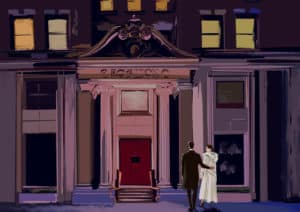
Glamor Hotels, Staging an Affair: The Royalton, New York 1994
The original Royalton, with its blue runway-like carpet beckoning guests into shadowy nooks and low-lit lounges, was a fully immersive experience. The hotel became about so much more than just checking in. The secrecy of the architecture, the seductiveness of the accent lights, and the intimacy of the lounge chairs tucked behind large mahogany columns — it was an atmosphere in which to mingle and recede, to both see and not be seen, to seduce and be seduced.

I vividly recall 1994: as a first-year architecture student, I was obsessed with Philippe Starck. He was teaching at our school while rising to fame in the design world, a mysterious, aristocratic personality that had fascinated me from the moment I met him at the facsimile gallery in Milano. I was interning right at the moment he’d introduced the world to the iconic Jim Nature television.
His appearances were always a mix of magic, mystery, and glamor — the trademarks so evident in his designs for the Royalton in New York, which that year became the second most profitable hotel in the United States, and a landmark of boutique hotels worldwide. At school, Starck was constantly telling us, “Life is a movie, and we are the minds who both set the scene and play in it.”
A hospitality revolution started in New York with Starck’s work on the Royalton. It was indisputably a Philippe Starck hotel that carried all his personality. Starck understood real hotel glamor, and this was the project that ushered in the wave of boutique hotels that followed — a wave that included a handful of standouts and many, many imitators.
So now, thirty years on, the term “boutique hotel” gets tossed around a lot. Despite its rampant overuse and abuse, despite the baggage it’s accrued, and despite some people’s insistence on seeing the designation as a cliché or a turn-off, a true urban boutique hotel is still a thing of seductiveness and glamor. When you find the right, tucked-away property, perched apart from the main thoroughfare, with true style and a clear sense of itself, you’ve stumbled upon a hidden world rich with possibility.
As Robert Bound writes in Monocle, “What is it about hotels? Managers and maitre d’s know. They’ve noticed that woman on a week-long business trip — whose husband sent flowers to the hotel on their anniversary — drop her keys in the breast pocket of a man who’s just added a night to his stay.”

For developers and designers who strive for originality, creating a true glamor hotel is now a challenging proposition. So much of the hospitality world has given way to homogeneity and the obvious. An in-your-face blog post like “5 Ways to Do a Boutique Hotel” likely won’t help much. William Smith from Studio Tack points out that you want to stay authentic and that designers should invite developers to partake in the story. “Authenticity encourages us to pick up our brains, not just a color.”
Even with decades in the industry and a vast swath of projects behind me, I’ve learned to take myself back to 1994 — back to my time as a student under Starck’s tutelage. I return to the mindset that allows me to envision life as a movie. I understand that when we develop or reposition hotels, we must locate a concept that allows people to believe in them. We are birthing a space where the lives are authentic, the walls tell a story, and the love affair is real.


